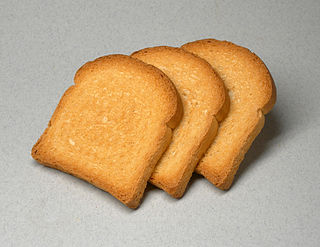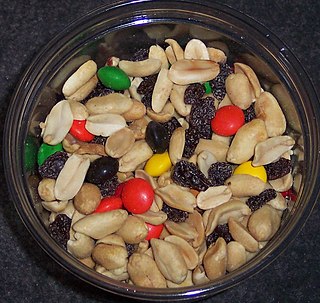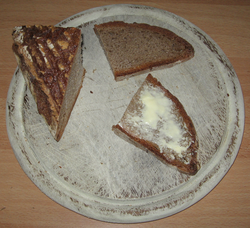
A sandwich is a food typically consisting of vegetables, sliced cheese or meat, placed on or between slices of bread, or more generally any dish wherein bread serves as a container or wrapper for another food type. The sandwich began as a portable, convenient finger food in the Western world, though over time it has become prevalent worldwide.

Hungarian or Magyar cuisine is the cuisine characteristic of the nation of Hungary, and its primary ethnic group, the Magyars. Hungarian cuisine has been described as being the spiciest cuisine in Europe. This can largely be attributed to the use of their piquant native spice, Hungarian paprika, in many of their dishes. A mild version of the spice, Hungarian sweet paprika, is commonly used as an alternative. Traditional Hungarian dishes are primarily based on meats, seasonal vegetables, fruits, bread, and dairy products.

Finnish cuisine is notable for generally combining traditional country fare and haute cuisine with contemporary continental-style cooking. Fish and meat play a prominent role in traditional Finnish dishes in some parts of the country, while the dishes elsewhere have traditionally included various vegetables and mushrooms. Evacuees from Karelia contributed to foods in other parts of Finland in the aftermath of the Continuation War.

A fried egg is a cooked dish made from one or more eggs which are removed from their shells and placed into a frying pan and fried. They are traditionally eaten for breakfast in many countries but may also be served at other times of the day.

An open sandwich, also known as an open-face/open-faced sandwich, bread baser, bread platter or tartine, consists of a slice of bread or toast with one or more food items on top. It has half the amount of bread of a typical closed sandwich.

A canapé is a type of hors d'oeuvre, a small, prepared, and often decorative food, consisting of a small piece of bread or cracker, wrapped or topped with some savoury food, held in the fingers and often eaten in one bite.

An English muffin is a small, round and flat yeast-leavened bread which is commonly 4 in (10 cm) round and 1.5 in (3.8 cm) tall. It is generally sliced horizontally and served toasted. In North America, Australia and New Zealand, it is frequently eaten with sweet or savoury toppings such as butter, fruit jam, honey, eggs, sausage, bacon, or cheese. English muffins are an essential ingredient in eggs Benedict and a variety of breakfast sandwiches derived from it, such as the McMuffin, and can be used in place of other breads for French toast.
Dutch cuisine is formed from the cooking traditions and practices of the Netherlands. The country's cuisine is shaped by its location in the fertile North Sea river delta of the European Plain, giving rise to fishing, farming and overseas trade. The Burgundian-Habsburg court enriched the cuisine of the Dutch elite in the 15th and 16th century, so did the colonial spice trade in the 17th century.

A rusk is a hard, dry biscuit or a twice-baked bread. It is sometimes used as a teether for babies. In some cultures, rusk is made of cake, rather than bread: this is sometimes referred to as cake rusk. In the UK, the name also refers to a wheat-based food additive.

Smørrebrødsmørbrød "butter bread" (Norwegian), is a traditional open-faced sandwich in the cuisines of Denmark, Norway and Sweden that usually consists of a piece of buttered rye bread, topped with commercial or homemade cold cuts, pieces of meat or fish, cheese or spreads, and garnishes.

Torta is a culinary term that can, depending on the cuisine, refer to cakes, pies, flatbreads, sandwiches, or omelettes.

Motabbaq is a stuffed pancake or pan-fried bread which is commonly found in the Arabian Peninsula and Southeast Asia, notably in Saudi Arabia, Yemen, Indonesia, Malaysia, Singapore, Brunei, Southern Thailand and Bangladesh. Depending on the location, the name and ingredients can significantly vary. The name mutabbaq in Arabic means "folded". It is a popular street food in Yemen, Indonesia, Malaysia, Thailand and Singapore.

Toast is sliced bread that has been browned by radiant heat. The browning is the result of a Maillard reaction altering the flavor of the bread and making it firmer. The firm surface is easier to spread toppings on and the warmth can help butter reach its melting point. Toasting is a common method of making stale bread more palatable. Bread is toasted using a toaster or a toaster oven. Toast may contain acrylamide caused by the browning process, which is suspected to be a carcinogen. However, claims that acrylamide in burnt toast causes cancer have not been proven.

Regional street food is street food that has commonalities within a region or culture.

Northern Irish cuisine encompasses the cooking styles, traditions and recipes associated with Northern Ireland. It has distinctive attributes of its own, but has also drawn heavily from Irish and British cuisines.

A snack is a small portion of food generally eaten between meals. Snacks come in a variety of forms including packaged snack foods and other processed foods, as well as items made from fresh ingredients at home.
Breakfast, the first meal of the day eaten after waking from the night's sleep, varies in composition and tradition across the world.



















